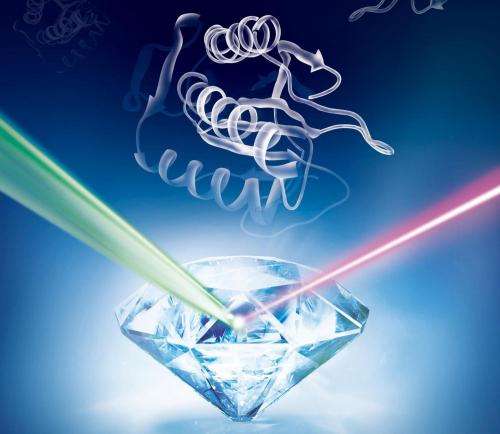March 6, 2015 report
Researchers develop a way to observe spin in a portion of a cell cycle

(Phys.org)—A team of researchers working in China has developed a technique that allowed them to observe spin in a portion of a cell cycle. In their paper published in the journal Science, the team describes their technique, how it can be used and where they plan to go next. Phillip Hemmer and Carmen Gomes, with Texas A&M University offer a Perspective piece on the work done by the team in China in the same journal issue.
To really understand how biology works, scientists need to see living cells doing what they do at the atomic level, unfortunately, because of the delicate nature of living tissue, that goal has not been achieved. One such example is proteins—they engage in a myriad of tasks inside the body, mostly due to their physical shape, but researchers have no way to see those shape changes actually taking place. In this new effort, the researchers used an adapted form of Magnetic Resonance Imaging to provide them with an ability to observe atomic spin in one portion of a protein cell while it was still alive, thus offering clues about the changing shape of the protein as a whole.
A standard MRI machine allows for viewing living tissue inside the body, but it is not capable of providing fine enough resolution for cellular, much less atomic level observations. In this latest effort, the researchers looked to a diamond nanomagnetometer as a suitable stand-in. In essence it is a small diamond with a defect—one with a nitrogen vacancy center—when combined with a laser, it can be used to read electron spin states at room temperature, but only on the surface of the diamond lattice. The researchers in China have found a way to extend those capabilities to allow for reading spin states that are not on the surface, i.e. those at a distance—and that allows for observation of conformational changes, such as those that occur in proteins.
The team acknowledges that much more work needs to be done, observation of more than one spin at a time, for example is needed to create accurate portrayals of the shape transformations that occur with whole proteins. But this work is certainly a big step in that direction. Also, the bulk diamond used by the team would have to be replaced with a nanodiamond for the technique to work in general.
More information: Single-protein spin resonance spectroscopy under ambient conditions Science 6 March 2015: Vol. 347 no. 6226 pp. 1135-1138 . DOI: 10.1126/science.aaa2253
Abstract
Magnetic resonance is essential in revealing the structure and dynamics of biomolecules. However, measuring the magnetic resonance spectrum of single biomolecules has remained an elusive goal. We demonstrate the detection of the electron spin resonance signal from a single spin-labeled protein under ambient conditions. As a sensor, we use a single nitrogen vacancy center in bulk diamond in close proximity to the protein. We measure the orientation of the spin label at the protein and detect the impact of protein motion on the spin label dynamics. In addition, we coherently drive the spin at the protein, which is a prerequisite for studies involving polarization of nuclear spins of the protein or detailed structure analysis of the protein itself.
Journal information: Science
© 2015 Phys.org





















